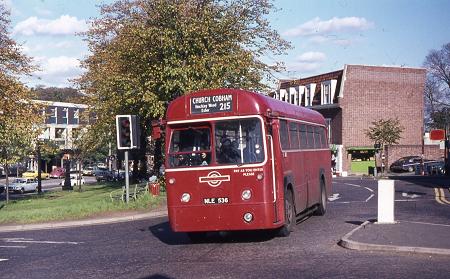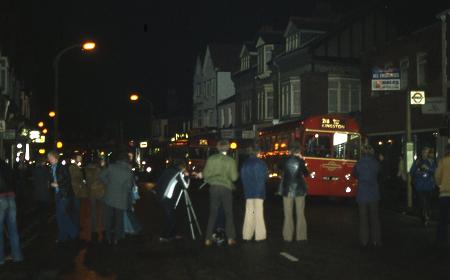 The RF Story The RF Story
Part 5 - Maturity
In final form, with
nearside-number route blind and painted 'Pay as you enter' signage,
RF536 departs Esher for Cobham on 16 Oct 76.
Photo © John Parkin
The Reshaping Plan
As the reduction in passenger numbers that started in the 1950s
gathered pace and the attractions of cost reduction by
double-decking continued, the inevitable contraction in the
single-deck fleet continued in the 1960s. The first RFs to be
sold, in 1963 when only twelve years old, were the Private
Hire coaches that had been converted to Green Lines but made
surplus by the arrival of the RMCs; twenty four coach RFs were also
sold the following year. Primarily a casualty of the staff
shortages that had also been worsening since the 1950s was the
Private Hire fleet, with the RFs and RFWs being sold in 1963 and
1964.
However, the staff shortages and the arguments about Central
Area OMO led in 1963 to the Phelps-Brown Committee of
Inquiry. One-man operation gave a new lease of life to
the RF in 1964, but LT's response went further, leading to the
infamous Reshaping Plan which brought
wholesale change in 1968. In both the Country and Central
Areas, OMO conversion meant using the RF, providing work for
surplus buses and coaches in replacing crew RTs in a reversal of
the previous trend towards double-decking where possible.
This process started in the Central Area in October 1965 with the
20B at Loughton and continued
in some cases to use RFs after the introduction of more modern
types, with the 212 in September 1971,
the last new red RF route.
Through the upheavals of the Merlin era, the RFs quietly kept
running. After the early Green Line disposals in 1964, there
were no mass withdrawals until after the Country Area had been
transferred to the National Bus Company as London Country on 1 Jan
70, talking with it 413 RFs. That company found profits hard
to come by, with an ageing fleet and rapidly falling passenger
numbers. The RFs inherited from LT fared
better than the RTs, which were early targets for replacement by
one man buses. But the falling requirement as well as
deliveries of new single-deck coaches led to the sale of surplus
RFs from 1971.
In the Central Area, LT retained 233 red RFs at the start of
1970, eight more than originally delivered. At that time,
there were still four crew-operated red RF routes, the 208, 210, 227 and 236, the first
three of which had operated RFs since the introduction of the class
in 1952/3. The 210 was converted to OMO RF operation in
January 1970, the other routes lost their RFs for new buses (and in
the case of the 208, a new number, the S2) within 16 months.
Most of the buses from the 208 provided the last batch to be
converted for OMO use, the so-called 'Uxbridge RFs', but
46 from the 227 and 236 were withdrawn permanently when the routes
were converted in January and April 1971.
Mass withdrawal
The one-person buses continued in service in diminishing
numbers through the 1970s, outlasting some of
their successors. 1973 saw the next withdrawal of a
batch of red RFs, with the main fleet planned to finish
by 1976. By that year, London Country had withdrawn most
of their RFs, but they were tougher than many of the other buses
and continued to be useful in small numbers. The last of all,
RF202, outlasted the red RFs, working from Northfleet until
gearbox failure in July 1979 caused an abrupt end.
Plans for the replacement of RFs in the Central
Area in 1976 led to their withdrawn from no fewer than 16
routes in 1976, leaving RFs working just
six routes - Kingston's 218 and 219, Hounslow's 202 (the second RF route to bear that number) and
237, the 234A at Croydon and
Edgware's 251. The latter two
were converted to BL operation in January, with Hounslow following
in April - the 237 having been in continuous RF operation since
December 1952, a period of over 24 years.
Recertification
But London Transport had a problem. They had planned to
convert the 218 and 219 (which together needed 19 buses) to SMD Swift
operation, but these buses were too long for the pits at Kingston
garage, and the unions would not accept them. There were no
more BLs available, so a batch of RFs (reported as 25,
but see details in the Appendix) were
reconditioned and certified for a further three years' service, the
work being carried out at Hanwell and Stonebridge garages.
Note however that RFs with earlier certificates (and old-style
livery) continued in service until early 1978.
 The 218 and 219 (known to local crews as the 8s
and 9s) therefore continued as the sole operators of RFs in LT,
until finally a solution was found to the Kingston problem - by
transferring the routes to Norbiton garage. So with due
ceremony (and a week before the end of the RTs on the 62), the last RFs ran in London service on Friday
30 Mar 79, the last one home being RF507 in the early hours of 31
March. RF507 had been specially prepared for the occasion, in
traditional red and cream livery and still with gold-underlined
fleet names, by Steve Fennell, Paul Morris and Dave Simmons of
Norbiton and Kingston garages. The following day, a
commemorative run over routes 218 and 219 was operated by RFs 510,
511 and 512.
RF507 attracted a crowd for its last journey,
which unlike the RTs a week later was at the end of the evening
service.
See also the memories of red RF
operation recorded by LT staff and others. Details of the
routes worked by red RFs are in the Routes
section. General background to the London Transport route
structure is here. For more
information, see the Bibliography.
|